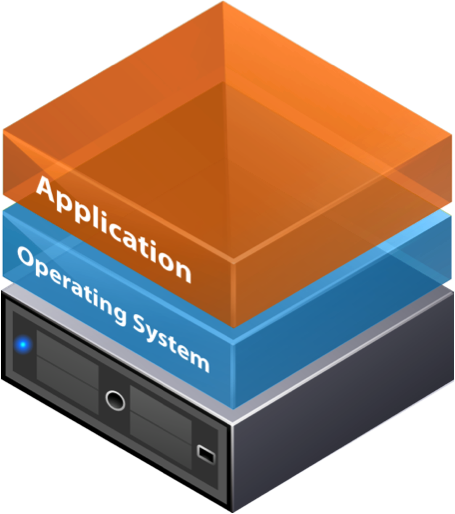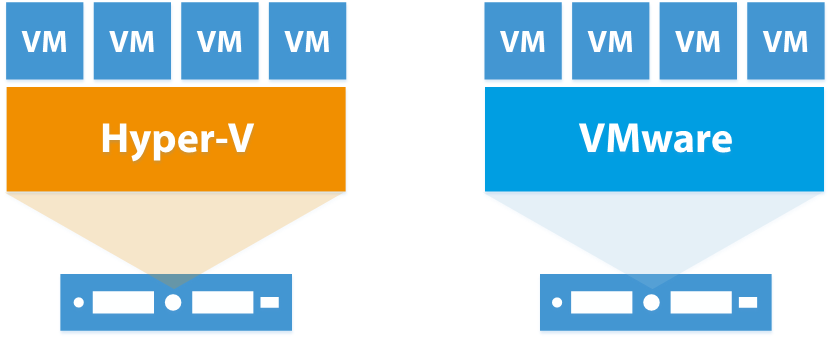What Is Virtualization?
In the IT sense of the word, anything “virtual” is a representation of something that does not physically exist. Virtual Private Networks (VPN), Virtual Memory, virtual reality, virtual game worlds such as that of World Of Warcraft, and of course as it pertains to this article, Virtual Machines (VMs).
Virtualization is the act of separating operating systems and software from the physical hardware it runs on by placing an abstraction layer between them. Put simply, it turns the “computer” into an ethereal state that isn’t tied to the physical confines of the hardware.
Why Virtualize?
Take for example the images below.
|
|
|
On the left we see the concept traditionally applied to general computing. Applications run on the operating system which runs on the hardware. Efficiency is quite low and in most cases the processor would be idle 80-90 percent of the time. Backups must be made to an external disk or network location from within the context of the computer it is backing up, subjecting it to potential configuration errors and faults. Adding hardware may require that the system be powered down on-site and physically maintained. If usage requirements change, system resources cannot easily be altered or redistributed.
On the right, VMware is acting as the virtual abstraction, separating and acting as a liaison between multiple hosted applications and operating systems, and the hardware itself. In the second example, available processor cycles are distributed between multiple operating systems running in tandem on the same computer hardware, thereby improving efficiency. Each VM can be paused, backed up and started outside the confines of the individual system. Memory, network devices and even storage can be added or redistributed (and even remotely) without interrupting the operations of the Virtual Machines. If the host hardware fails, the VM images can be migrated to a new physical host without regard to drivers or capacity. Virtual machine images can be placed in any state in standby, allowing new, fully installed and configured server images to be activated within seconds as needed.
Not only can the hardware host multiple Virtual Machines, but also many different operating systems. Some businesses require many different operating systems for separate departments and software necessities. One company might need both a Microsoft Server 2008 domain controller but also a Red Hat Linux web server. Once upon a time, that company would have to bite the bullet and invest in two separate hardware servers. Now, all this is possible on a single server.
A few years ago I held a position as a network administrator in charge of maintaining approximately thirty servers (most virtualized) at any given time, and virtualization afforded me flexibility and fault-tolerance that was otherwise not possible. When testing a patch or other general system change, it was easy to click a button to save the system state, then make a change. If anything other than the desired result happened, I clicked another button and went back to the way it was before in a matter of seconds. The value of this “undo button” cannot be overstated.
Things To Consider
The IT world changes so fast sometimes that it takes a while for it to catch up with itself. Virtualization has been around for years but traditional software licensing restrictions struggled to fit the concept of virtualization with accepted definitions of a “computer. Microsoft originally defined a license as being permitted to run on a single CPU. Then, when multiple CPU computers came about, they had to revise the wording. Then again when virtualization came along, Microsoft at first required that a new license needed to be purchased for every “instance” of their operating system. Microsoft eventually rethought the entire licensing structure and loosened restrictions enough to allow unlimited virtual machines provided the top-level host operating system was the Datacenter Edition of Windows. What’s more, Microsoft went a step further and released its own virtualization software known as Hyper-V, a variation of the term HyperVisor, the basis of which the virtualization technology came into existence.
Microsoft’s Hyper-V is available as part of the Windows Server 2008 system, and VMware’s VMware Server 2 is available for a free download for relatively simple infrastructure. More robust options are available for additional licensing fees.


[…] are green software solutions, too. Instead of running multiple costly servers, consider virtualization or outsourcing your infrastructure via cloud computing. With virtualization, you can run multiple […]